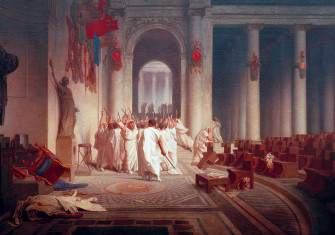A Grecian Harvest Home
A scene of ancient Arcadian bliss which hints at the coming of modernity.

Young men and women dance around the combined figures of Sylvanus and Pan to the sound of pipes and tabors, in a scene rooted in the Georgics of Virgil. Sylvanus, meaning ‘of the woods’ in Latin, is represented as an ageing male figure, watching over forests, fields and the fortunes of farmers, whose divisions and boundaries of land he enforces. Pan, with the horns and legs of a goat, represents the other side of nature: rustic, wild, beyond human convention. He and his companions, the nymphs, conjure up an untamed sexuality, fertile and spring-like. These gods were honoured during harvest, too.
On the left, peasants carouse amid flowers, fruit and agricultural tools. A peacock, symbol of death and resurrection, reminds the viewer of the passing of the seasons and their renewal. In the background, agricultural labourers bind corn and keep bees. The theme of fertility is further enhanced by the marriage procession taking place in the Arcadian fields. In the top left corner, three gods associated with the rural, the fertile and the festive look down approvingly on the bucolic scene: Pan is joined by Ceres, benevolent god of the grain and motherhood, and Bacchus, god of ecstasy, excess and wine. Bacchus, known to the Greeks as Dionysius, gave his name to the kind of festival he and his gods are witnessing: Dionysia.
But there is a contemporary twist to the painting, one of a series by the Irish artist James Barry, entitled The Progress of Human Culture and Knowledge, commissioned by London’s Society of Arts in the 1770s to adorn its Great Room, as the Industrial Revolution accelerated. The wrestlers, at the left of the painting, are symbols of the nascent sporting contests the Greeks pioneered; not just the Olympics, but also the Isthmian and Nemean games, the subject of the next painting in the series. Yet, in their grappling, they also embody the emerging capitalist ideas of competition and struggle, which in this particular world view, in turbulent, ingenious and irreverent 18th-century Britain, lie at the root of civilisation’s advance.






